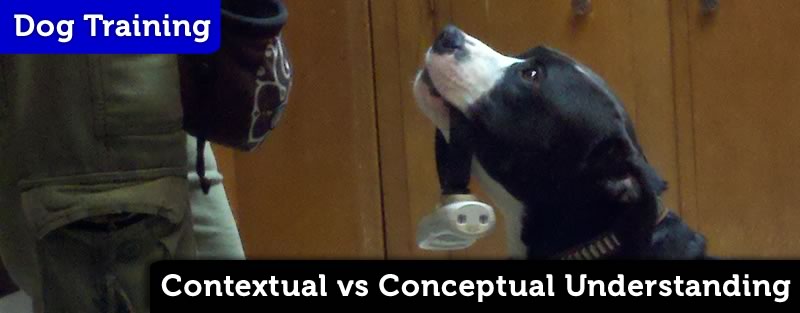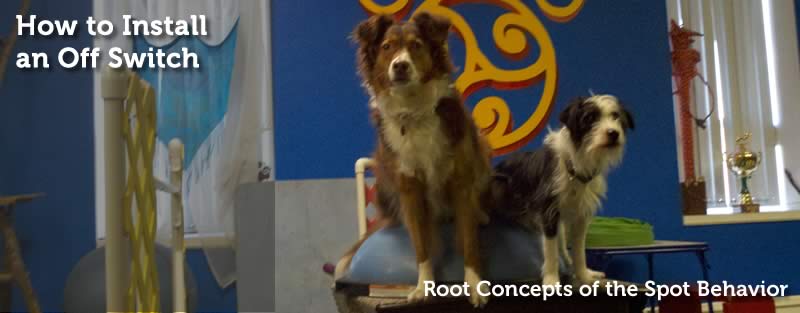
Root Concepts of the Spot Behavior
Behaviors can be broken down into many root concepts. We can mark and reinforce any or all of these in order to draw attention to them so we can use them in the future.
Spot training offers us several active root concepts that we can teach our dogs that will come in handy in other situations:
- Targeting
- ThresholdA dog’s working state can be said to be over or under Threshold. A dog that is over Threshold has trouble working. A dog that is under Threshold is in good shape to... More
- Foot Target
- On
- Off
- Duration BehaviorAny behavior performed until the handler wants it to stop is a Duration Behavior. Duration Behaviors have 3 parts. There is an action,”Yes!”. Then there is the duration part filled with Classical Conditioning... More (sit or down)
Threshold
Understanding that the space on one side of the threshold is different than the space on the other is an important part of understanding the environment. Dogs surely know all about this concept but they probably don’t know that we know about it, or that we, as a team, should be concerned with it.
Understanding that a threshold is something to be conscious of allows for all kinds of team actions to be better understood. The threshold in the Spot or Pedestal behaviors are the edges of the spot or pedestal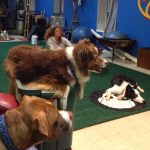 Spot is a “go to a place”, or “go to a mat” behavior. This means that the dog seeks out and performs a duration behavior on a spot of the handler’s choosing. A... More. Marking when the dog crosses this threshold will draw attention to it and allow you to reward for position.
Spot is a “go to a place”, or “go to a mat” behavior. This means that the dog seeks out and performs a duration behavior on a spot of the handler’s choosing. A... More. Marking when the dog crosses this threshold will draw attention to it and allow you to reward for position.
Having a clear and well generalized understanding of the threshold of a spot makes it much easier for the dog to generalize spots.
Foot Target
You can mark the moment a foot hits the spot and reinforce to get more feet on or to maintain the foot target. Dropping cookies on the mat is great for this as is paying above the center of the spot. Paying high (above the dog’s head) on a spot will eventually lead to a sit. Paying in the center of the spot above the dog’s head will lead to a sit in the center of the spot. See Reward Placement .
1 Foot
You can reinforce getting a foot on the Spot, it’s the first step after all. But you must be careful to not get stuck on that first step.
You will mark this initially, or when we need to raise or rate of reinforcement when a session’s flow starts to suffer, but outside of those situations you’ll need to up the ante and start reinforcing behaviors that more closely resemble the finished product. More feet on…
2 Feet
Two feet on the target is a good step towards the completed behavior, but again, you need to move forward quickly once the behavior is happening frequently.
You can (and probably should) use Reward placement to take this from 2 feet to 4 feet.
4 Feet
Eventually you need to raise the criteria to putting all 4 feet on the spot. This will require waiting and that the handler has added enough value to the 4 feet on the spot for the dog to have good reason to put those 4 feet on there. Once 4 feet are on, it’s time to shovel until the release.
Sit
Once you have the dog reliably holding the Spot you can then start to work on our chosen duration behavior.
In the case of a Sit, holding/presenting reinforcement above the dogs head should promote a Sit.
Also, if the team has a strong history of unsolicited eye contact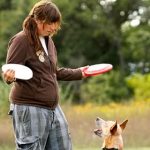 Unsolicited eye contact or Attention is a great way to hook up with a dog. If you have something the dog wants he should give eye contact in order to get access to... More, a sit is often guaranteed with a lack of action and/or a mark on the first piece of eye contact.
Unsolicited eye contact or Attention is a great way to hook up with a dog. If you have something the dog wants he should give eye contact in order to get access to... More, a sit is often guaranteed with a lack of action and/or a mark on the first piece of eye contact.
Another thing that you can do is to mark and withold reinforcement. This often yields a Sit.
Once Sit happens you pump your dog full of cookies, give your release cue, and pay the dog somewhere off the Spot.
Down
If you want a Down on the Spot, which is really what you’re looking for, you’ll move from the sit to down by paying the dog very low – down between the dog’s front feet and chest. Withold the cookie until the dog either lies down or starts to lie down.
This reward placement will promote a down because it’s hard to eat a cookie there while sitting. The elbows have to bend to get at the cookie. Once the elbows bend it’s an uncomfortable position. Give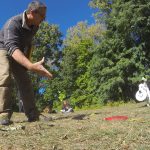 The Give is a retrieve to the hand. A cued Give is a foundational skill that is not super useful in the actual performance of disc dog freestyle, and has huge applications for... More it a few seconds and the down pretty much happens. You can shape the Down a bit my marking the initial bending of the elbows for the down and upping the ante.
The Give is a retrieve to the hand. A cued Give is a foundational skill that is not super useful in the actual performance of disc dog freestyle, and has huge applications for... More it a few seconds and the down pretty much happens. You can shape the Down a bit my marking the initial bending of the elbows for the down and upping the ante.
If the butt comes off the floor at any time, remove the reinforcement and start again.
Working a bunch of the Down behavior, making it a ‘hot’ behavior will increase the likelihood of the dog offering that behavior.






